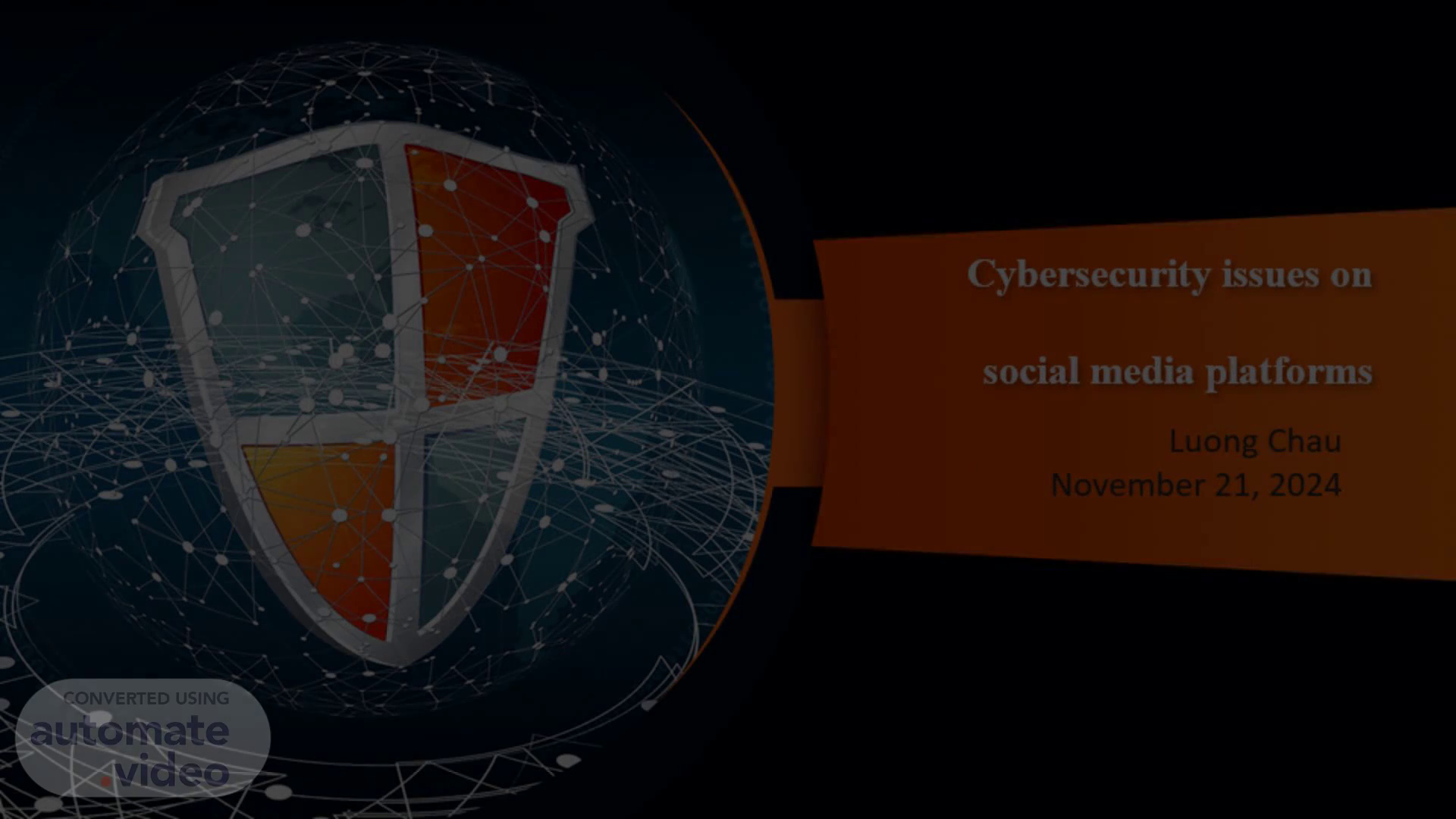Scene 1 (0s)
[Audio] Good afternoon, everyone. My name is Lucas. My presentation today focuses on a critical issue in our digital world: cyberbullying and its impact on mental health. Cyberbullying is not just a modern form of harassment; it has unique characteristics that make it particularly harmful, especially for adolescents..
Scene 2 (21s)
[Audio] Over the next few minutes, I'll discuss what is Privacy and Security in Online Social Networks, also cyberbullying and how it affects mental health, and what can be done to address it. Let's begin with privacy and security in online social networks..
Scene 3 (37s)
[Audio] Online social networks have transformed how we connect, from Facebook and Instagram to LinkedIn and Twitter. These platforms allow users to communicate and share our lives with a global audience. However, they also collect vast amounts of personal data, and this information can be vulnerable to misuse. As we embrace the benefits of these networks, we must also be aware of the risks involved. The key question is: how can we engage with social media safely while protecting our privacy?.
Scene 4 (1m 11s)
[Audio] For the privacy threats. There are two main types of threats in online social networks: classic and modern threats. Classic threats, such as phishing, malware, and spam, have existed since the early days of the internet. Phishing attempts trick users into revealing personal information, while malware attacks often compromise your device. Modern threats, on the other hand, are more specific to social networks. Clickjacking tricks users into clicking on hidden, malicious links, and fake profiles deceive users to collect sensitive data. Another growing concern is how OSNs use user data for advertising. This allows third parties to target users based on their activity, creating privacy issues like surveillance and profiling. These privacy threats can lead to unwanted consequences, from identity theft to constant tracking. Before the protective measures, I want to explain more about the cyberbullying and how it impact to the mental health of a person after being in that situation..
Scene 5 (2m 16s)
[Audio] What is Cyberbullying? Cyberbullying involves using digital platforms like social media, messaging apps, or gaming communities to intentionally harm or harass others. Unlike traditional bullying, it can happen anytime, day or night, and allows perpetrators to remain anonymous. Forms of cyberbullying include sending hateful messages, sharing embarrassing images, spreading rumors, and deliberately excluding someone from online communities. One example might be a group chat where participants gang up on someone, making them feel unwelcome or targeted. This anonymity and constant accessibility make cyberbullying particularly challenging to escape and deal with..
Scene 6 (3m 1s)
[Audio] From the stats, we can see that cyberbullying affects of adolescents worldwide. This variation depends on factors such as region, internet usage, and survey methods. Adolescents who spend more than three hours a day online—especially on social media or messaging apps—are at higher risk of becoming victims or perpetrators. Additionally, those who have experienced traditional bullying are more likely to encounter cyberbullying. Imagine a student who was bullied in school; now, through social media, they might continue to be targeted, even in their own home. This digital extension amplifies the psychological impact..
Scene 7 (3m 44s)
[Audio] For the victims that got cyberbullying, the consequences are severe and wide-ranging. For instance, they will experience depression, anxiety, low self-esteem, and even suicidal thoughts. They also experience compounded emotional and social issues, such as anger, frustration, and isolation, making them especially vulnerable to mental health disorders..
Scene 8 (4m 11s)
[Audio] Let me share some specific findings to highlight the gravity of this issue. In one study, adolescents reported psychosomatic symptoms like headaches, sleep disturbances, and stomachaches following cyberbullying incidents. These physical manifestations are often overlooked but are just as significant as the emotional toll. Victims often avoid school or social settings due to fear and embarrassment, further isolating them and worsening their mental health. Cyberbullying doesn't only affect the individual but can strain family relationships and disrupt peer groups, creating a ripple effect of harm..
Scene 9 (4m 54s)
[Audio] Because of the seriousness and consequences of the problem, we need to take security measures and raise user awareness. Start by using strong, unique passwords for each platform. Change your passwords regularly, especially if you suspect your account may have been compromised. Social media platforms often provide customizable privacy settings—be sure to use them to limit who can see your posts and personal information. Also, avoid using third-party applications unless necessary, as these can sometimes compromise your data. Installing antivirus software and keeping it up to date will help defend against malware and other malicious attacks. Finally, be mindful of the personal information you share online. The less you disclose, the less you expose yourself to potential threats.here are several actions you can take to protect your privacy on social networks..
Scene 10 (5m 48s)
[Audio] In conclusion, social media provides amazing ways to connect with others, but it also exposes users to significant privacy and security risks. By understanding these risks and taking basic steps to protect yourself—such as using stronger passwords, customizing your privacy settings, and avoiding unnecessary data sharing—you can enjoy these platforms safely. The ultimate goal is to stay connected but also stay protected. Thank you for your attention!.
